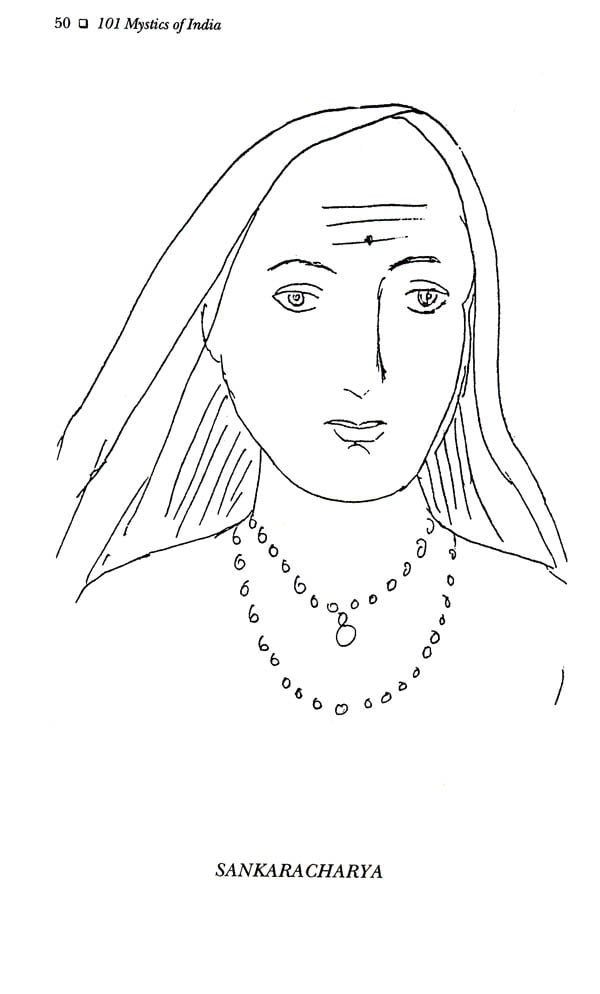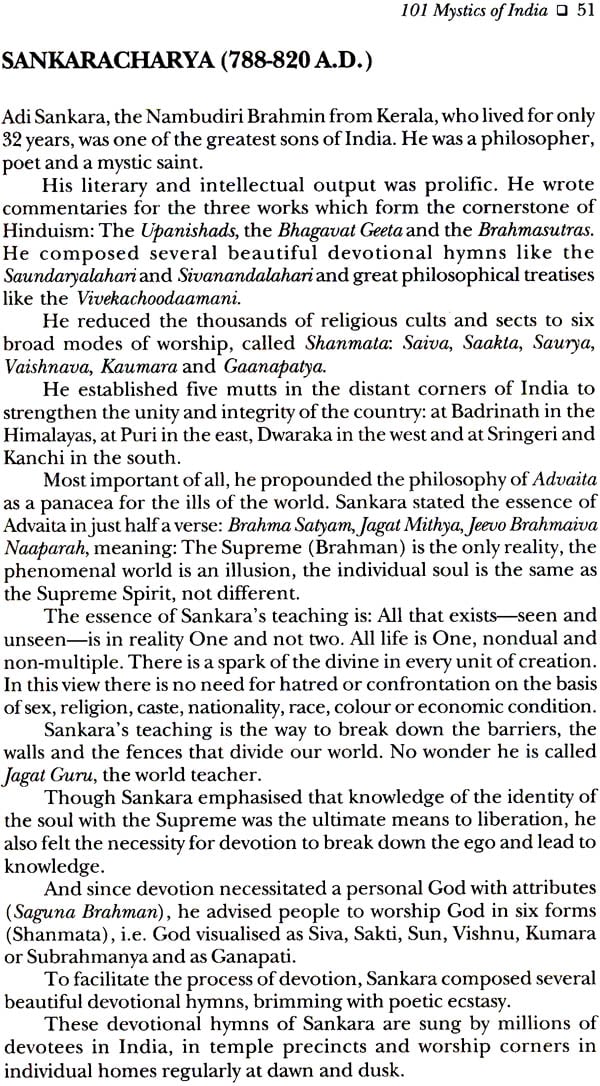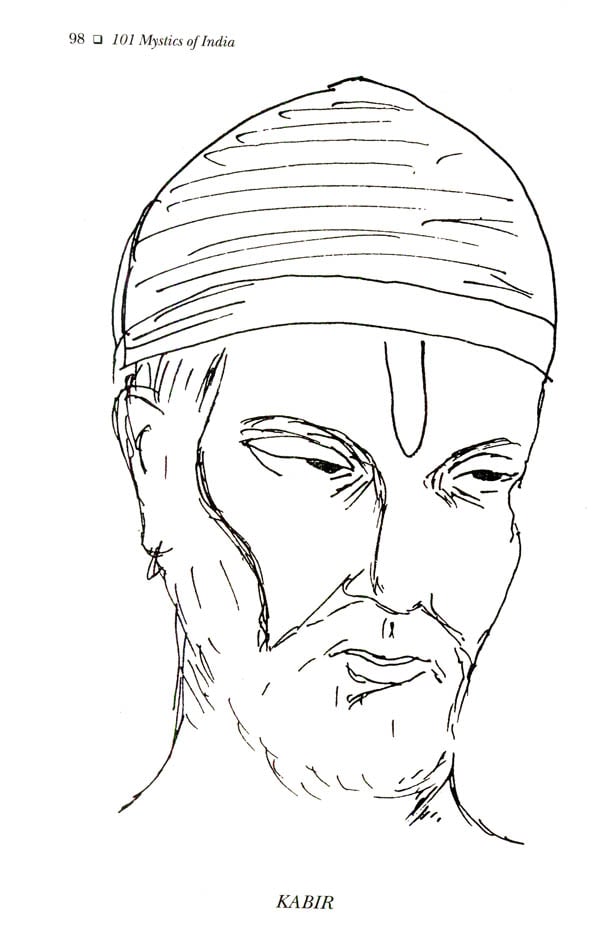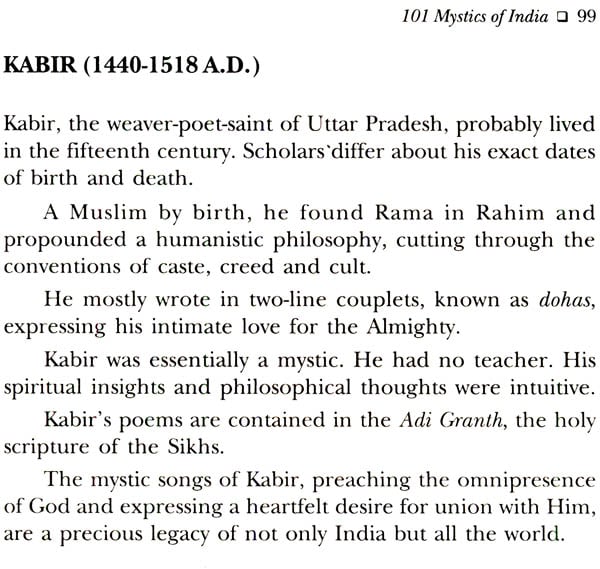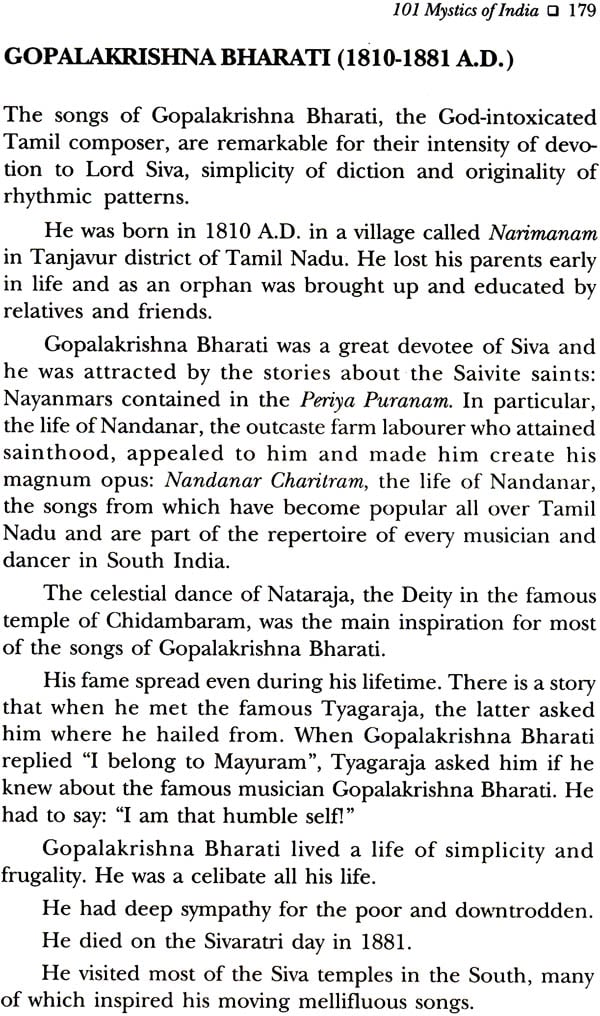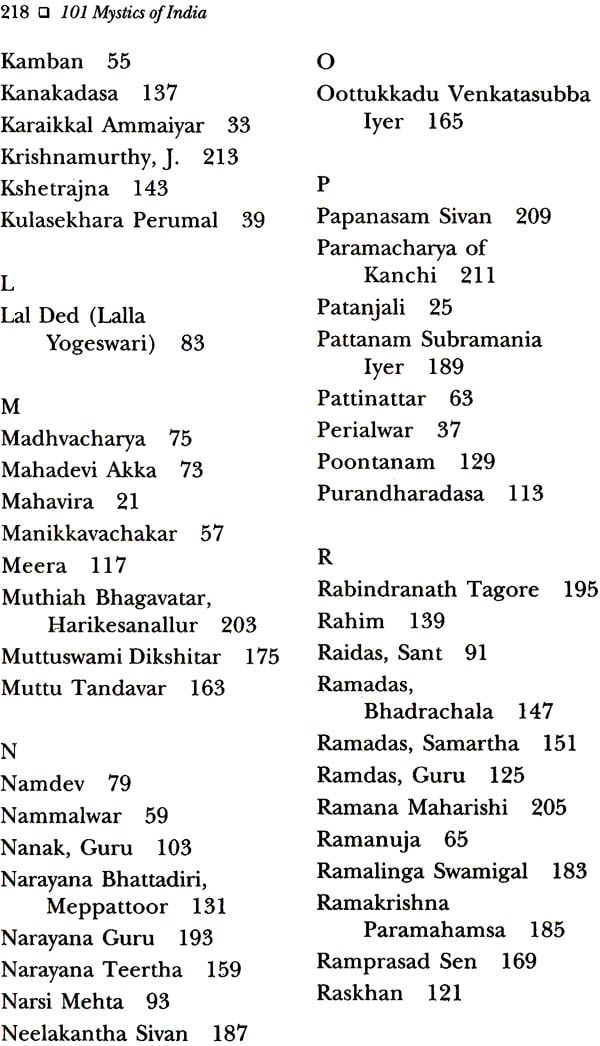
101 Mystics of India (An Old and Rare Book)
Book Specification
| Item Code: | IDI074 |
| Author: | V. K. Subramanian |
| Publisher: | ABHINAV PUBLICATION |
| Edition: | 2006 |
| ISBN: | 97881701747166 |
| Pages: | 219 (Black & White Figures: 101) |
| Cover: | Hardcover |
| Other Details | 5.7"X 8.7" |
| Weight | 460 gm |
Book Description
101 MYSTICS OF INDIA is a valuable compilation by the scholar- artist-author V. K. Subramanian, whose ten-volume series Sacred Songs of India- the result of loving and laborious research spread over several years is already before the discerning public.
The book gives brief life sketches (side by side with pictorial representations) of 101 Mystics who graced the world from 2500 B.C. to the twentieth century in an unbroken continuity defying the barriers of region, language gender and social status. All of them had one passion: an intense longing to decipher the Divine and to unite with the supreme. All of them had the experience of communion with the Transcendent ( and immanent) Reality and they expressed that experience by establishing new religions propounding new philosophies creating monumental works of literature composing soul-stirring lyrics of devotion or simply casting a hypnotic spiritual spell by their living model.
The mystics of India have sprouted in every part of India: Andra Pradesh Assam Bengal Bihar, Gujarat, Karnataka, Kashmir, Kerala, Maharashtra, Orissa, Punjab, Tamil Nadu and Utter Pradesh.
101 mystics of India will be an invaluable reference book to scholars of Indology and to all those sons and daughters of India who live scattered across the globe a precious reminder of their spiritual heritage.
Vadakaymadom Krishna Iyer Subramanian (b. 1930, Kerala, India) is an eminent scholar, whose life mission is to present to the world the treasures of ancient India, in the fields of art literature, philosophy and religion.
He has already translated several ancient texts into English.
These include: Saundaryalahari, Sivanandalahari, Sacred Songs of India, Maxims of Chanakya, Sri Rudraprasna and Wondrous Whispers of Wisdom from Ancient India.
As a consultant for holistic health and apiritual development he has spelt out the Hindu regimens in this regard in this popular book The Holistic Way to Health, Happiness and Harmony
Subramanian's prolific literary output covers a variety of subjects ranging from astrology to art. He has been an astropalmic counselor for over 35 years.
A retired officer of the Indian Audit and Accounts Service (which he joined in 1953), Subramanian is also a reputed Painter, who has held 22 one -man shows and whose paintings (some of them in the Chandigarh Museum) have won wide acclaim from leading art critics of India.
Subramanian who has traveled extensively in India now lives in the United States of America.
I have pleasure and pride in presenting 101 Mystics of India to my readers.
Who is a Mystic?
The American Heritage Dictionary of the English Language defines a mystic as one who experiences an immediate consciousness of the transcendent or ultimate reality or god and describes the experience of such communion.
The expression of experience of a mystic can be the establishment of a philosophy or religion the creation of a monumental work of art like an epic the composition of devotional lyrics set to melodious music by themselves and others, or observance of an inspiring silence which can spark spiritual awakening in devotees.
The mystics of India all the categories.
Thus we have Gautama Buddha and Mahavira establishing new religions as a result of their mystical experience; sages like Valmiki and Veda Vyasa writing epics; Kalidasa creating immortal plays and poems; Patanjali, Sankara, Ramanuja and Madhvacharya propounding diverse philosophical doctrines; and the innumerable mystics of the Bhakti movement pouring out their mystical experience in soulful musical compositions.
Under the last category come the Alwars (like Nammalwar, Perialwar, Tirumangai Azhwar, Kulasekhara Perumal and others) and Nyanmars (like Sundarar, Appar, manikkavachkar, Tirujnanasambandhar and others); the saints of maharashtra like Tukaram, Eknath, Jnaneswar and Samartha Ramadas and the stalwarts like Tulsidas, Surdas, Kabir, Vallabhacharya, Narsi Mehta, Rahim, Raskhan, Dadu Dayal and Bulleh Shah; the musical composers of the South like Tyagaraja, Muttuswami Dikshitar, Syama Sastri, Papanasam Sivan, Pattanam Subramania lyer, Mysore Vasudevachar, Swati Tirunal, Harikesanallur Muthaih Bhagavatar and scores of other Carnatic Music Composers like Oottukkadu Venkatasubba lyer, Gopalakrishna Bharati, Neelakantha Sivan, etc.
The sprouting of mystics in India has defied the constrictions of region, language gender and time.
Prominent mystics from Karnataka include Veerassaivite leaders like Devara Dasimayya, Allama Prabhu and Basavanna and such outstanding devotees like Kanakadasa and Purandharadasa.
Mystics from Andhra Pradesh include: Annamacharya, Kshetrajna, Bhadrachala Ramadas, Sadasiva Brahmendra and Narayana Teertha.
Mystics from Punjab are the Sikh Gurus like Guru Nanak, Guru Arjan Dev, Guru Amar Das, Guru Ramdas and Guru Tegh Bahadur.
Among the mystics from Kerala most prominent are Poontanam, Narayana Bhattadiri, Ezhuttacchan, Narayana Guru, Bilwa Mangal and Iriyamman Tampi.
Among the mystics Tamil mystics come Agastya Avvaiyar, tirumoolar, Arunagirinathar, Kamban, the creator of the classic Kamba Ramayana, Ilango Adikal, the author of Silappadikaram, Tiruvalluvar, author of the famous Tirukkural Pattinattar Tayumanavar, Muttu Tandavar, Abhirami Bhattar, Appayya Dikshitar and Vedanta Desikan.
Illustrating the irrelevance of religion, come Sankaradeva from Assam Bhima Bhoi, the tribal chief of Orissa, Shahji Maharaja of Tanjore and Ramprasad Sen of Bengal.
Among the women mystics come Karaikkkal Ammaiyar Andal, Mahadevi Akka, Jana Bai, Meera and Lal Ded (Lalla Yogeswari) of Kashmir.
Continuing the unbroken chain down the centuries we have in modern times such stalwarts like Sri Aurobindo Ramakrishna Paramahamsa, Swami Vivekananda, Subramania Bharati Suddhananda Bharati, Rabindranath Tagore, Ramalinga Swamigal, Ramana Maharishi, Paramacharya of Kanchi and Jiddu Krishnamurthy.
In compiling this list of 101 mystics of India, I am definitely guilty of omission of important savants. I may be forgiven for my incomplete, whimsical and arbitrary selection.
I may also be forgiven for the Shortness of presentation. I can in my defence, only refer to the allegory mentioned by Anton Chekhov to George Sand:
"Why are your songs so short?" the bird was asked.
"Are you short of breath?"
The bird replied: "No. I have many songs to sing and I want the world to hear them all.
| Introduction | 11 | |
| 1 | Agastya (2500 B.C.) | 15 |
| 2 | Valmiki (14th- 15th century B.C.) | 17 |
| 3 | Veda Vyasa (13th century B.C.) | 19 |
| 4 | Mahavira (599-526 B.C.) | 21 |
| 5 | Gautama Buddha (566-486 B.C.) | 23 |
| 6 | Patanjali (200-150 B.C.) | 25 |
| 7 | Ilango Adikal (2nd century A.D.) | 27 |
| 8 | Tirmoolar (3rd -5th century A.D.) | 29 |
| 9 | Tiruvalluvar (5th century A.D.) | 31 |
| 10 | Karaikkal Ammaiyar (5th century A.D.) | 33 |
| 11 | Kalidasa (6th century A.D.) | 35 |
| 12 | Perialwar (6th -7th century A.D.) | 37 |
| 13 | Kulasekhara Perumal (6th -7th century A. D.) | 39 |
| 14 | Appar (Tirunavukkarasu) (7th century A.D.) | 41 |
| 15 | Avvaiyar (7th century A.D.) | 43 |
| 16 | Tirujnanasambandhar (7th century A.D.) | 45 |
| 17 | Andal (7th century A.D.) | 47 |
| 18 | Tirumangai Azhwar (8th century A.D.) | 49 |
| 19 | Sankaracharya (788-820 A.D.) | 51 |
| 20 | Sundarar (8th -9th century A.D.) | 52 |
| 21 | Kamban (9th century A.D.) | 55 |
| 22 | Manikkavachakar (9th century A.D.) | 57 |
| 23 | Nammalwar (880-930 A.D.) | 59 |
| 24 | Devara Dasimayya (10th century A.D.) | 61 |
| 25 | Pattinatter (10th century A.D.) | 63 |
| 26 | Ramanuja (1017-1137 A.D.) | 65 |
| 27 | Jayadeva (12th century A.D.) | 67 |
| 28 | Basavanna (1106-1167 A.D.) | 69 |
| 29 | Allama Prabhu (12th century A.D.) | 71 |
| 30 | Mahadevi Akka (12th century A.D.) | 73 |
| 31 | Madhvacharya (1199-1278 A.D.) | 75 |
| 32 | Vedanta Desikan (1268-1369 A.D.) | 77 |
| 33 | Namdev (1270-1350 A.D.) | 79 |
| 34 | Jnaneswar (1275-1296 A.D.) | 81 |
| 35 | Lal Ded (Lalla Yogeswari) (14th century A.D.) | 83 |
| 36 | Bilwa Mangal (14th century A.D.) | 85 |
| 37 | Jana Bai (14th century A.D.) | 87 |
| 38 | Vidyapati (1350-1460 A.D.) | 89 |
| 39 | Sant Raidas (1500-1576 A.D.) | 91 |
| 40 | Narsi Mehta (1414-1480 A.D.) | 93 |
| 41 | Chandidas (1417-1477 A.D.) | 95 |
| 42 | Annamacharya (1424- 1503 A.D.) | 97 |
| 43 | Kabir (1440- 1518 A.D.) | 99 |
| 44 | Sankaradeva (1449-1569 A.D.) | 101 |
| 45 | Guru Nanak(1469-1538 A.D.) | 103 |
| 46 | Vallabhacharya (1424-1503 A.D.) | 105 |
| 47 | Guru Amar Das (1469-1538 A.D.) | 107 |
| 48 | Arunagirinathar (15th century A.D.) | 109 |
| 49 | Surdas (1483- 1563 A.D.) | 111 |
| 50 | Purandharadasa (1484-1564 A.D.) | 113 |
| 51 | Chaitanya Mahaprabhu (1486-1534 A.D.) | 115 |
| 52 | Meera (1498-1547 A.D.) | 117 |
| 53 | Tulsidas (1532-1623 A.D.) | 119 |
| 54 | Raskhan (1533-1588 A.D.) | 121 |
| 55 | Eknath (1533-1606 A.D.) | 123 |
| 56 | Guru Ramdas (1534-1581 A.D.) | 125 |
| 57 | Dadu Dayal (1544-1603 A.D.) | 127 |
| 58 | Poontanam (1547-1640 A.D.) | 129 |
| 59 | Meppattoor Narayana Bhattadiri (1560-1655 A.D.) | 131 |
| 60 | Guru Arjan Dev (1563-1606 A.D.) | 133 |
| 61 | Tunchattu Ezhuttacchan (16th century A.D.) | 135 |
| 62 | Kanadasa (16th century A.D.) | 137 |
| 63 | Rahim (16th century A.D.) | 139 |
| 64 | Appayya Dikshitar (16th -17th century A.D.) | 141 |
| 65 | Kshetrajna (17th century A.D.) | 143 |
| 66 | Sadasiva Brahmendra (17th century A.D.) | 145 |
| 67 | Bhadrachala Ramadas (17th century A.D.) | 147 |
| 68 | Tukaram (1608-1650 A.D.) | 149 |
| 69 | Samartha Ramadas (1608-1681 A.D.) | 151 |
| 70 | Guru Tegh Bahadur (1621-1675 A.D.) | 153 |
| 71 | Bulleh Shah (1684-1752 A.D.) | 155 |
| 72 | Shahji Maharaja (1684-1710 A.D.) | 157 |
| 73 | Narayana Teertha (18th century A.D.) | 159 |
| 74 | Abhirami Bhattar (18th century A.D.) | 161 |
| 75 | Muttu Tandavar (18th century A.D.) | 163 |
| 76 | Oottukkadu Venkatasubba lyer (1700-1765 A.D.) | 165 |
| 77 | Tayumanavar (1705-1742 A.D.) | 167 |
| 78 | Ramprasad Sen (1723-1803 A.D.) | 169 |
| 79 | Syama Sastry (1762-1827 A.D.) | 171 |
| 80 | Tyagaraja (1767-1847 A.D.) | 173 |
| 81 | Muttuswami Dikshitar (1775-1835 A.D.) | 175 |
| 82 | Iriyamman Tampi (1782-1856 A.D.) | 177 |
| 83 | Gopalakrishna Bharati (1810-1881 A.D.) | 179 |
| 84 | Swati Tirunal (1813-1846 A.D.) | 181 |
| 85 | Ramalinga Swamigal (1823- 1857 A.D.) | 183 |
| 86 | Ramakrishna Paramahamsa (1836-1886 A.D.) | 185 |
| 87 | Neelakantha Sivan (1839-1900 A.D.) | 187 |
| 88 | Pattanam Subramania lyer (1845-1902 A.D.) | 189 |
| 89 | Bhima Bhoi (1849-1894 A.D.) | 191 |
| 90 | Narayana Guru (1856-1928 A.D.) | 193 |
| 91 | Rabindranath Tagore (1861-1941 A.D.) | 195 |
| 92 | Swami Vivekananda (1863-1902 A.D.) | 197 |
| 93 | Mysore Vasudevachar (1865-1961 A.D.) | 199 |
| 94 | Sri Aurobindo Ghosh (1872-1950 A.D.) | 201 |
| 95 | Harikesanallur Muthiah Bhagavatar (1877-1945 A.D.) | 203 |
| 96 | Ramana Maharishi (1879-1950 A.D.) | 205 |
| 97 | Subramania Bharati (1882-1921 A.D.) | 207 |
| 98 | Papanasam Sivan (1890-1973 A.D.) | 209 |
| 99 | Paramacharya of Kanchi (1894-1994 A.D.) | 211 |
| 100 | J. Krishnamurthy (1895-1986 A.D.) | 213 |
| 101 | Suddhananda Bharati (1897-1937 A.D.) | 215 |
| Index | 217 |
